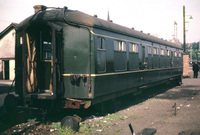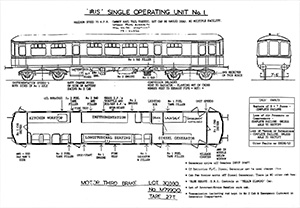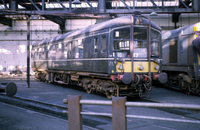Derby Lightweight (Yellow Diamond) 1, 2 & 4-car DMUs
Non-Passenger Use
When the Derby Lightweights were withdrawn from passenger use there was no interest in DMU preservation. Thankfully, some vehicles survived long enough in departmental use for this attitude to change so they can be appreciated today.
| Original | Prefix | New | Type | Details | From | To |
|---|---|---|---|---|---|---|
| 79018 | DB | 975007 | DMBS | Ultrasonic Test Train | 11/70 | 1994 |
| 79185 | DB | 975012 | DMBS | Brake trials test coach | 1/68 | 6/70 |
| 79250 | TDB | 975013 | DTS | Staff messroom, Craigentinny | 6/67 | 4/77 |
| 79252 | TDB | 975014 | DTS | Staff messroom | 6/67 | 11/77 |
| 79612 | DB | 975008 | DTC | Ultrasonic Test Train | 11/70 | 1994 |
| 79649 | DB | 999510 | DTC | Special Saloon | 1960 | 1981 |
| 79900 | RDB | 975010 | DMBS | Route Learner / Railway Technical Centre | 10/67 | 6/99 |
Special Saloon
M79649 was converted to a special saloon for use by the LMR General Manager in 1957, it would later be transferred to departmental stock as DB999510 for use by the Civil Engineers Department. More details.
Staff Messrooms

Two DTCs - 79250 and 79252 - became 975013 and 975014 after withdrawal from the Scottish Region in 1967. It seems they initally went to Dundee as staff mess coaches. The image shows the grounded body of 975014 at Dundee West shed on 12 August 1969. It would later be re-united with its bogies. David Mant.
They would move to Edinburgh circa 1970 where they would be used as staff messrooms/stores vehicles at Craigentinny depot. In 1971 they were found to be coupled together, both still in lined green, 975013 externally complete, 975014 had had (most) of the cab end repainted - including the cab windows.
975014 would move to Glasgow by 1974, first to Bellahouston Carriage Sidings then Salkend Street Parcels Depot where it remained until 1979. It would eventually be scrapped at Snailwell.
975013 never left Craigentinny, in the summer of 1975 it was noted as being used as a store for the "Exmover" chemicals used to clean carriage exteriors. The cab had sustained some damage, the buffers/buffer beam had been hit and were pointing down towards the ground. It was noted wrapped in polythene in Spring 1977, and cut up on site in February 1978[1].
Route Learners
One of the single cars, 79900, went into departmental use in 1967 as a Eastern Region route learner based at York. It would be renumbered as 975010. The image shows it in York roundhouse on 9/8/70. David Mant.
Two withdrawn Scottish vehicles - 79036 + 79189 - would also perform route learning duties on the Eastern Region in 1968, possibly based at York. These route learners were a regular feature in the Spring months for several years: they originated in West Yorkshire and took men over the route to Brid and Scarborough in preparation for the summer extras to the coastal resorts. In the previous year they had utilised Brush Type 4's and old coaches and, in 1966, they had had still-new Brush Type 4's at the head of a rake of brand new merry-go-round coal hoppers (later HAA's). This had the effect of killing three birds with one stone: the men gained route knowledge, traction knowledge on the new locos and experience of handling the new merry-go-round wagons.[2]
The pair are seen in the images passing West Parade North Junction on the Scarborough line at Hull at lunchtime on their return from the coast on a day in May 1968. M79900 was photographed on the same duty a week or two later. Leonard Rogers.
Other route learning use of 79900 was in preparation for the introduction of the Huddersfield-Penistone-Sheffield Midland DMU service on 5 January 1970 with the vehicle noted running on the route in the previous month.[3]
Ultrasonic Test Train
West Cumberland vehicles M79018 / M79612 became DB975007/975008 forming the Ultrasonic test train for the Civil Engineers Department operating from 1971 till 1994. More details.
Railway Technical Center - "Iris"

By 1974 the ER Route Learner 975010 had been transferred to the Derby RTC, and gained the prefix RDB and the name "Test Car Iris". For many years it carried the RTC red/blue livery, and performed a variety of tasks around the country. It included pioneer work on BR’s National Radio Network, involving radio strength reception tests in areas where cab signalbox communication was to be introduced. A lab with technical instrumentation was installed in the centre section.
The image shows the vehicle at Inverness on 9/7/84, probably there in connection with the introduction of RETB working on the Kyle and Far North Lines. Kenneth Leiper.

The layout drawing, an amended version of the vehicle's original diagram, shows the alterations that were made inside and contains some other notes for the operating staff.
At some point the yellow diamond style drivers controls were replaced with the blue square type, and by 1995 it was repainted into a version of original green livery with small yellow panel.
Near the end the AEC engines became unreliable and two Class 101 power cars were used as tractor units. It was withdrawn in June 1999, It was later preserved, bought by one of the RTC engineers that worked on it.
References
- ⋏ Comments on 975014 page, Departmentals.com
- ⋏ Email Leonard Rogers to Stuart Mackay 19 December 2020
- ⋏ image p142 March 1970 The Railway Magazine
Summary
Description
- Single cars
- Four-car sets
Drivers Instructions
Numbering
Liveries
Operations
- West Cumberland
- Lincolnshire
- East Anglia
- North Eastern Region
- Buckingham - Banbury
- Manchester
Non-Passenger Use
- Special Saloon
- Ultrasonic Test Train
Images
Details about preserved Derby Lightweights can be found here.




